Tarot
The tarot (/ˈtæroʊ/, first known as trionfi and later as tarocchi or tarock) is a pack of playing cards, used from the mid-15th century in various parts of Europe to play games such as Italian tarocchini, French tarot and Austrian Königrufen, many of which are still played today. In the late 18th century, some tarot decks began to be used for divination via tarot card reading and cartomancy leading to custom decks developed for such occult purposes.[1]

Like common playing cards, the tarot has four suits which vary by region: French suits in Northern Europe, Latin suits in Southern Europe, and German suits in Central Europe. Each suit has 14 cards: ten pip cards numbering from one (or Ace) to ten, and four face cards (King, Queen, Knight, and Jack/Knave/Page). In addition, the tarot has a separate 21-card trump suit and a single card known as the Fool; this 22-card section of the tarot deck is known as the major arcana. Depending on the game, the Fool may act as the top trump or may be played to avoid following suit.[2] These tarot cards are still used throughout much of Europe to play conventional card games without occult associations.
Among English-speaking countries where these games are not played frequently, tarot cards are used primarily for novelty and divinatory purposes, usually using specially designed packs.[2] Some who use tarot for cartomancy believe that the cards have esoteric links to ancient Egypt, the Kabbalah, Indian Tantra, or the I Ching, though scholarly research has not found documented evidence of such origins or of the usage of tarot for divination before the 18th century.[2][3]
History

Playing cards first entered Europe in the late 14th century, most likely from Mamluk Egypt. The first records date to 1367 in Berne and they appear to have spread very rapidly across the whole of Europe, as may be seen from the records, mainly of card games being banned. Little is known about the appearance and number of these cards; the only significant information being provided by a text by John of Rheinfelden in 1377 from Freiburg im Breisgau, who, in addition to other versions describes the basic pack as containing the still-current 4 suits of 13 cards, the courts usually being the King, Ober and Unter ("marshals"), although Dames and Queens were already known by then.
One early pattern of playing cards that evolved was one with the suits of Batons or Clubs, Coins, Swords, and Cups. These suits are still used in traditional Italian, Spanish and Portuguese playing card decks, but have also been adapted in packs used specifically for tarot divination cards that first appeared in the late 18th century.[4]
The first documented tarot packs were recorded between 1440 and 1450 in Milan, Ferrara, Florence and Bologna when additional trump cards with allegorical illustrations were added to the common four-suit pack. These new decks were called carte da trionfi, triumph cards, and the additional cards known simply as trionfi, which became "trumps" in English. The earliest documentation of trionfi is found in a written statement in the court records of Florence, in 1440, regarding the transfer of two decks to Sigismondo Pandolfo Malatesta.[5][6]
The oldest surviving tarot cards are the 15 or so Visconti-Sforza tarot decks painted in the mid-15th century for the rulers of the Duchy of Milan.[7] A lost tarot-like pack was commissioned by Duke Filippo Maria Visconti and described by Martiano da Tortona probably between 1418 and 1425, since the painter he mentions, Michelino da Besozzo, returned to Milan in 1418, while Martiano himself died in 1425. He described a 60-card deck with 16 cards having images of the Roman gods and suits depicting four kinds of birds. The 16 cards were regarded as "trumps" since in 1449 Jacopo Antonio Marcello recalled that the now deceased duke had invented a novum quoddam et exquisitum triumphorum genus, or "a new and exquisite kind of triumphs".[8] Other early decks that also showcased classical motifs include the Sola-Busca and Boiardo-Viti decks of the 1490s.[2]
In Florence, an expanded deck called Minchiate was used. This deck of 97 cards includes astrological symbols and the four elements, as well as traditional tarot motifs.[2]
Although a Dominican preacher inveighed against the evil inherent in cards (chiefly owing to their use in gambling) in a sermon in the 15th century,[9] no routine condemnations of tarot were found during its early history.[2]
Because the earliest tarot cards were hand-painted, the number of the decks produced is thought to have been small. It was only after the invention of the printing press that mass production of cards became possible. The expansion of tarot outside of Italy, first to France and Switzerland, occurred during the Italian Wars. The most important tarot pattern used in these two countries was the Tarot of Marseilles of Milanese origin.[2]
Etymology
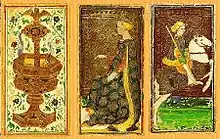
The word Tarot and German Tarock derive from the Italian Tarocchi, the origin of which is uncertain but taroch was used as a synonym for foolishness in the late 15th and early 16th centuries.[10][11] The decks were known exclusively as Trionfi during the fifteenth century. The new name first appeared in Brescia around 1502 as Tarocho.[12] During the 16th century, a new game played with a standard deck but sharing a very similar name (Trionfa) was quickly becoming popular. This coincided with the older game being renamed tarocchi.[2] In modern Italian, the singular term is Tarocco, which, as a noun, refers to a cultivar of blood orange. The attribute Tarocco and the verb Taroccare are used regionally to indicate that something is fake or forged. This meaning is directly derived from the tarocchi game as played in Italy, in which tarocco indicates a card that can be played in place of another card.[13] [14]
Tarot gaming decks
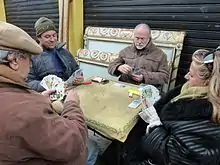
The original purpose of tarot cards was to play games. A very cursory explanation of rules for a tarot-like deck is given in a manuscript by Martiano da Tortona before 1425. Vague descriptions of game play or game terminology follow for the next two centuries until the earliest known complete description of rules for a French variant in 1637.[15] The game of tarot has many regional variations. Tarocchini has survived in Bologna and there are still others played in Piedmont and Sicily, but in Italy the game is generally less popular than elsewhere.
The 18th century saw tarot's greatest revival, during which it became one of the most popular card games in Europe, played everywhere except Ireland and Britain, the Iberian peninsula, and the Ottoman Balkans.[16] French tarot experienced another revival beginning in the 1970s and France has the strongest tarot gaming community. Regional tarot games—often known as tarock, tarok, or tarokk are widely played in central Europe within the borders of the former Austro-Hungarian empire.
Italian-suited tarot decks

These were the oldest form of tarot deck to be made, being first devised in the 15th century in northern Italy. Three decks of this category are still used to play certain games:
- The Tarocco Piemontese consists of the four suits of swords, batons, cups and coins, each headed by a king, queen, cavalier and jack, followed by the pip cards for a total of 78 cards. Trump 20 outranks 21 in most games and the Fool is numbered 0 despite not being a trump.
- The Swiss 1JJ Tarot is similar, but replaces the Pope with Jupiter, the Popess with Juno, and the Angel with the Judgement. The trumps rank in numerical order and the Tower is known as the House of God. The cards are not reversible like the Tarocco Piemontese.
- The Tarocco Bolognese omits numeral cards two to five in plain suits, leaving it with 62 cards, and has somewhat different trumps, not all of which are numbered and four of which are equal in rank. It has a different graphical design than the two above as it was not derived from the Tarot of Marseilles.
Italo-Portuguese-suited tarot deck
The Tarocco Siciliano is the only deck to use the so-called Portuguese suit system which uses Spanish pips but intersects them like Italian pips.[17] Some of the trumps are different such as the lowest trump, Miseria (destitution). It omits the Two and Three of coins, and numerals one to four in clubs, swords and cups: it thus has 64 cards but the ace of coins is not used, being the bearer of the former stamp tax. The cards are quite small and not reversible.[9]
French-suited tarot decks
The illustrations of French-suited tarot trumps depart considerably from the older Italian-suited design, abandoning the Renaissance allegorical motifs. With the exception of novelty decks, French-suited tarot cards are almost exclusively used for card games. The first generation of French-suited tarots depicted scenes of animals on the trumps and were thus called "Tiertarock" ('Tier' being German for 'animal') appeared around 1740. Around 1800, a greater variety of decks were produced, mostly with genre art or veduta. Current French-suited tarot decks come in these patterns:
- Industrie und Glück – the Industrie und Glück ("Diligence and Fortune"[lower-alpha 1]) genre art tarock deck of Central Europe uses Roman numerals for the trumps. It is sold with 54 cards; the 5 to 10 of the red suits and the 1 to 6 of the black suits are removed. There are 3 patterns – Types A, B and C – of which Type C has become the standard, whereas Types B and C appear in limited editions or specials.
- Tarot Nouveau – also called the Tarot Bourgeois – has a 78-card pack. It is commonly used for Tarot games in France and for Danish Tarok in Denmark. It is also sometimes used in Germany to play Cego. Its genre art trumps use Arabic numerals in corner indices.
- Adler-Cego – this is an animal tarot that is used in the Upper Rhine valley and neighbouring mountain regions such as the Black Forest or the Vosges It has 54 cards organized in the same fashion as the Industrie und Glück packs. Its trumps use Arabic numerals but within centered indices.
- Schmid-Cego - this pack by F.X. Schmid has genre scenes similar to those of the Tarot Nouveau, but the Arabic numerals are centred as in the Adler-Cego pack.
 Example of 18th century "Tiertarock"
Example of 18th century "Tiertarock" Salzburg veduta trumps, circa 1840
Salzburg veduta trumps, circa 1840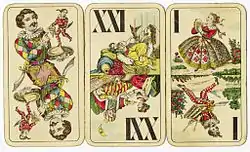 Industrie und Glück Tarock trumps
Industrie und Glück Tarock trumps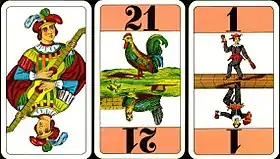 Cego trumps
Cego trumps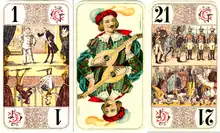 Tarot Nouveau trumps circa 1910
Tarot Nouveau trumps circa 1910
German-suited tarot decks
The German states used to produce a variety of 78-card Tarot packs, today, there are only two: both designs of Cego pack - Cego Adler by ASS Altenburger and Cego with genre scenes by F.X. Schmid, both of which are French-suited. There are, however, cards that were and are marketed as 'Tarock' cards. These are standard 36-card German-suited decks for Bauerntarock, Württemberg Tarock and Bavarian Tarock. They are not true tarot/tarock packs, but a Bavarian or Württemberg pattern of the standard German-suited decks with only 36 cards; the pip cards ranging from 6 to 10, Under Knave (Unter), Over Knave (Ober), King, and Ace. These use Ace-Ten ranking, like Klaverjas, where Ace is the highest followed by 10, King, Ober, Unter, then 9 to 6. The heart suit is the default trump suit.[2] The Bavarian deck is also used to play Schafkopf by excluding the Sixes.
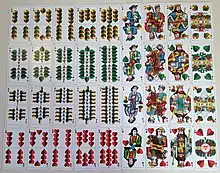 Württemberg Tarock cards
Württemberg Tarock cards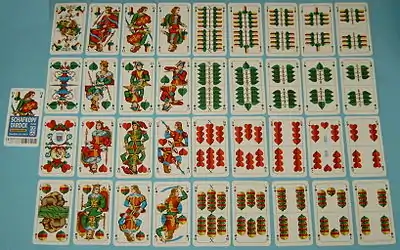
Tarot card reading
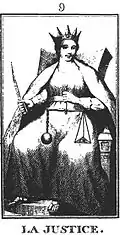
The earliest evidence of a tarot deck used for cartomancy comes from an anonymous manuscript from around 1750 which documents rudimentary divinatory meanings for the cards of the Tarocco Bolognese.[18][19] The popularization of esoteric tarot started with Antoine Court and Jean-Baptiste Alliette (Etteilla) in Paris during the 1780s, using the Tarot of Marseilles.[20] French tarot players abandoned the Marseilles tarot in favor of the Tarot Nouveau around 1900, with the result that the Marseilles pattern is now used mostly by cartomancers.
Tarot decks in occult usage
Etteilla was the first to issue a tarot deck specifically designed for occult purposes around 1789. In keeping with the unsubstantiated belief that such cards were derived from the Book of Thoth, Etteilla's tarot contained themes related to ancient Egypt.[20]
The 78-card tarot deck used by esotericists has two distinct parts:
- The Major Arcana (greater secrets), or trump cards, consists of 22 cards without suits:
- The Magician, The High Priestess, The Empress, The Emperor, The Hierophant, The Lovers, The Chariot, Strength, The Hermit, Wheel of Fortune, Justice, The Hanged Man, Death, Temperance, The Devil, The Tower, The Star, The Moon, The Sun, Judgement, The World, and The Fool. Cards from The Magician to The World are numbered in Roman numerals from I to XXI, while The Fool is the only unnumbered card, sometimes placed at the beginning of the deck as 0, or at the end as XXII.
- The Minor Arcana (lesser secrets) consists of 56 cards, divided into four suits of 14 cards each;
- Ten numbered cards and four court cards. The court cards are the King, Queen, Knight and Page/Jack, in each of the four tarot suits. The traditional Italian tarot suits are swords, batons, coins and cups; in modern occult tarot decks, however, the batons suit is often called wands, rods or staves, while the coins suit is often called pentacles or disks.
The terms "Major Arcana" and "Minor Arcana" were first used by Jean-Baptiste Pitois (also known as Paul Christian) and are never used in relation to tarot card games. Some decks exist primarily as artwork, and such art decks sometimes contain only the 22 major arcana.
The three most common decks used in esoteric tarot are the Tarot of Marseilles, the Rider-Waite-Smith tarot deck, and the Thoth tarot deck.[20]
Aleister Crowley, who devised the Thoth deck along with Lady Frieda Harris, stated of the Tarot: "The origin of this pack of cards is very obscure. Some authorities seek to put it back as far as the ancient Egyptian Mysteries; others try to bring it forward as late as the fifteenth or even the sixteenth century ... [but] The only theory of ultimate interest about the Tarot is that it is an admirable symbolic picture of the Universe, based on the data of the Holy Qabalah."[21]
See also
Notes
- "Diligence and Fortune" is the contemporary meaning of the phrase Industrie und Glück. See, for example, Placardi, Carl (1766). Das Kaiserliche Sprach- und Wörterbuch, Cölln am Rhein: Metternich, pp. 72 and 83.
References
- Decker, Depaulis & Dummett 1996, p. ix.
- Dummett, Michael A. E; Mann, Sylvia (1980). The game of Tarot: From Ferrara to Salt Lake City. ISBN 9780715610145.
- Semetsky, Inna (2011). Re-Symbolization of the Self: Human Development and Tarot Hermeneutic. Rotterdam: Sense Publishers. p. 33. ISBN 978-94-6091-421-8.
- Donald Laycock in Skeptical—a Handbook of Pseudoscience and the Paranormal, ed Donald Laycock, David Vernon, Colin Groves, Simon Brown, Imagecraft, Canberra, 1989, ISBN 0-7316-5794-2, p. 67
- Pratesi, Franco (2012). "In Search of Tarot Sources". The Playing-Card. 41 (2): 100.
- Pratesi, Franco. Studies on Giusto Giusti at trionfi.com. Retrieved 4 February 2018.
- Dummett, Michael (1996). A Wicked Pack Of Cards. p. 25. ISBN 9780312162948.
- Pratesi, Franco (1989). "Italian Cards - New Discoveries". The Playing-Card. 18 (1, 2): 28–32, 33–38.
- Robert Steele. A Notice of the Ludus Triumphorum and some Early Italian Card Games; With Some Remarks on the Origin of the Playing Cards." Archaeologia, vol LVII, 1900: pp 185-200.
- Vitali, Andrea. About the etymology of Tarocco at Le Tarot Cultural Association. Retrieved 4 February 2018.
- Vitali, Andrea. Taroch - 1494 at Le Tarot Cultural Association. Retrieved 4 February 2018.
- Depaulis, Thierry (2008). "Entre farsa et barzelletta: jeux de cartes italiens autours de 1500". The Playing-Card. 37 (2): 89–102.
- ""Tarocco" in online vocabulary treccani". Retrieved 2020-09-09.
- ""Taroccare" in online vocabulary treccani". Retrieved 2020-09-09.
- Dummett, Michael; McLeod, John (2004). A History of Games Played with the Tarot Pack. Lewiston: The Edwin Mellen Press. pp. 17–21.
- Parlett, David (1990). The Oxford Guide to Card Games (1 ed.). Oxford: Oxford University Press. ISBN 0-19-214165-1.
- Tarocco Siciliano, early form at the International Playing-Card Society website. Retrieved 26 July 2015.
- Pratesi, Franco (1989). "Italian Cards: New Discoveries, no. 9". The Playing-Card. 17 (4): 136–145.
- Dummett, Michael (2003). "Tarot Cartomancy in Bologna". The Playing-Card. 32 (2): 79–88.
- Jensen, K. Frank (2010). "A Century with the Waite-Smith Tarot (and all the others...)". The Playing-Card. 38 (3): 217–222.
- Crowley, Aleister, "The Book of Thoth", Weiser Books, 1969, Massachusetts. pg.5.
Bibliography
- Decker, Ronald, Thierry Depaulis and Michael Dummett. A Wicked Pack of Cards. London: Duckworth. ISBN 0-7156-2713-9